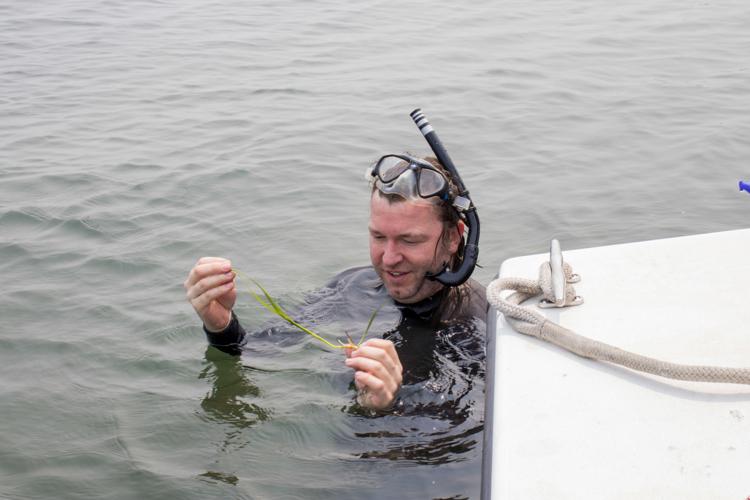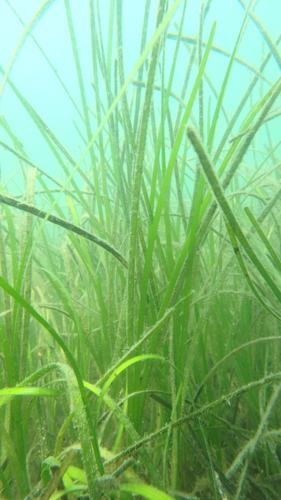Falmouth Is Losing Eelgrass. An Expert Explains Why That Matters
Falmouth Enterprise
Gilda Geist
August 17, 2023


Matthew H. Long, a marine chemist at the Woods Hole Oceanographic Institution, took time on a recent Tuesday to explain why eelgrass is so important and what its absence means for Falmouth.
What Is Eelgrass?
Eelgrass, scientific name Zostera marina, is a seagrass native to Cape Cod.
“Seagrasses actually evolved from land plants, so they’re not dissimilar from the grass in your front yard,” Dr. Long said.
Like the grass that makes up a front lawn, eelgrass has seeds, flowers, pollen, vascular systems and roots. It is good at stabilizing sediments and filtering out nitrogen (when nitrogen levels are not excessive) and it photosynthesizes, providing oxygen to the area.
Because eelgrass is so good at stabilizing sediments, eelgrass beds can serve as carbon sinks, holding carbon-rich organic matter on the seafloor. But when eelgrass starts to die off, the sediment breaks loose, and the carbon is eventually released into the atmosphere.
Eelgrass loss “is contributing to climate change,” Dr. Long said.
What Is Happening To The Eelgrass?
Thirty percent of seagrass meadows worldwide have already been lost, and it is estimated that an additional 7 percent are lost each year, Dr. Long said.
“They’re on par with degradation of coral reef ecosystems and tropical rainforests,” he said.
Eelgrass has vanished from Waquoit Bay, Dr. Long said.
Eelgrass needs a lot of light to grow, which is why it grows in shallow water. Macroalgae and phytoplankton that grow as a result of nutrient pollution coming from septic systems compete with eelgrass for resources, such as light and nutrients.
“In a lot of our coastal estuaries [in Falmouth], we have poor water quality, and it’s excluding seagrasses from those estuaries,” Dr. Long said.
Eelgrass is also sensitive to warming ocean temperatures, he said.
What Is So Bad About Losing Eelgrass?
Because eelgrass photosynthesizes, thereby oxygenating the water, a lack of eelgrass can lead to hypoxic conditions, meaning a lack of oxygen in the water.
“That’ll exclude everything else that lives there—all the fish, all the shellfish,” Dr. Long said. “There used to be a huge bay scallop fishery in Waquoit Bay, and that no longer exists, because without seagrasses you don’t have bay scallops.”
In addition, the sediment stabilization function of eelgrass makes the water clearer and less cloudy. This makes the water better for swimming and allows the eelgrass to store carbon.
Eelgrass is also good at absorbing wave energy, and hence buffeting against storms, Dr. Long said.
Can Eelgrass Be Restored?
To restore eelgrass beds, the town must tackle its wastewater issues, Dr. Long said.
“Unless you address that root cause of nutrient pollution, the seagrasses are going to continue to see those unfavorable conditions that exclude them from our coastal estuaries,” he said.
Once nutrient levels return to normal, eelgrass will likely come back on its own, Dr. Long said.
Dr. Long is currently working to develop a bioreactor to enhance denitrification in polluted estuaries. The bioreactor is designed to help remove organic nitrogen from the water by converting it to nitrogen gas that will go into the atmosphere, which is already 78 percent nitrogen.
Eelgrass And Education
Dr. Long has lived in Falmouth for about a decade and has done a lot of his research in Waquoit Bay. He raised concerns about shifting baseline syndrome, a phenomenon in which people do not notice the slow degradation of the environment because they forget or do not know what the natural environment used to look like.
“A really good, healthy coastal estuary looks like eelgrass on the bottom right near shore and those bay scallops that live there and nice clear water that you can see through,” Dr. Long said. “People don’t realize that’s the natural coastal estuary that used to be here.”
Education is an important part of fighting shifting baseline syndrome, Dr. Long said.
“Right now, people don’t care a lot about seagrasses, but they do care a lot about nutrient pollution,” he said. “Understanding the linkages between that nutrient pollution and what it’s done to our coastal estuaries and ultimately the seagrass beds, I think, is a very important aspect of all this.”
Dr. Long said sewering is a known, effective strategy in reducing nitrogen pollution and bringing back eelgrass.
“There’s some other ideas out there that are maybe not as well defined scientifically that are being pushed,” Dr. Long said. “Let’s focus on what we know works and advance that as best we can to clean up our nutrient pollution that, frankly, we’ve all caused.”
Falmouth Is Losing Eelgrass. An Expert Explains Why That Matters – Falmouth Enterprise
